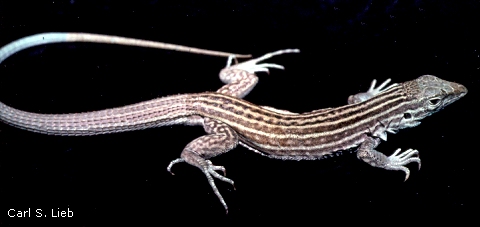
"A woman needs a man like a fish needs a bicycle." For some whiptail lizards, part of this war of the sexes has seemingly been won. In six species of Chihuahuan Desert whiptail lizards, all the individuals are female. These liberated reptiles produce unfertilized eggs that hatch only into daughters—clones of themselves.
Where did they come from? It seems that only a few hundred years ago,
two related species "hybridized", meaning a male of one species mated with a
female from another. The young, amazingly enough, were females who didn't need a
male to reproduce. Since all these lizards are females, they can produce more young
than a group that is half male. The same scenario happened other times, as well,
resulting in the six, distinct species of all-female lizards. Sometimes hybrid species
are especially robust, but this doesn't seem to be the case in these lizards. In
fact, most of them are slower and less wary around predators than lizards of other
species. What does this say about the persistence of this unisexuality over
evolutionary time? Stay tuned . . . a few thousand years should tell us if in this
case, the fish needs a bicycle, after all. 
Listen to the Audio (mp3 format) as recorded by KTEP, Public Radio for the Southwest.
Contributor: Carl S. Lieb, Laboratory for Environmental Biology, University of Texas at El Paso.
Desert Diary is a joint production of the Centennial Museum and KTEP National Public Radio at the University of Texas at El Paso.

New Mexican Whiptail, Cnemidophorus neomexicanus—one of the Chihuahuan Desert's all-female lizard species. Photograph by Carl S. Lieb.
Conant, R. G., and J. T. Collins. 1991. A field guide to reptiles and amphibians, eastern and central North America. Third Ed. Houghton Mifflin Co., Boston.
Degenhardt, W. G., C. W. Painter, and A. H. Price. 1996. Amphibians and reptiles of New Mexico. Univ. New Mexico Press, Albuquerque.
Wright, J. W. 1994. The North American deserts and species diversity in the lizards of the genus Cnemidophorus. Pp. 255-271, in Brown, P. R. and J. W. Wright (eds.), Herpetology of North American Deserts: Proceedings of a symposium. Southwest. Herpetol Soc. Spec. Publ. (5): iv + 311 pp.
Dawley, R. M., and J. P. Bogart (eds.). 1989. Evolution and ecology of unisexual vertebrates. Bull. New York State Mus. (466).
Paulissen, M. A. 1995. Comparative escape behavior of parthenogenetic and gonochoristic Cnemidophorus in south Texas. Copeia 1995(1):223-226.
Price, A. H. 1992. Comparative behavior in lizards of the genus Cnemidophorus (Teiidae), with comments on the evolution of parthenogenesis in reptiles. Copeia 1992(2):323-331.
Wright, J. W. and L. J. Vitt (eds.). 1993. Biology of Whiptail lizards (genus Cnemidophorus). Oklahoma Mus. Nat. History: Norman.